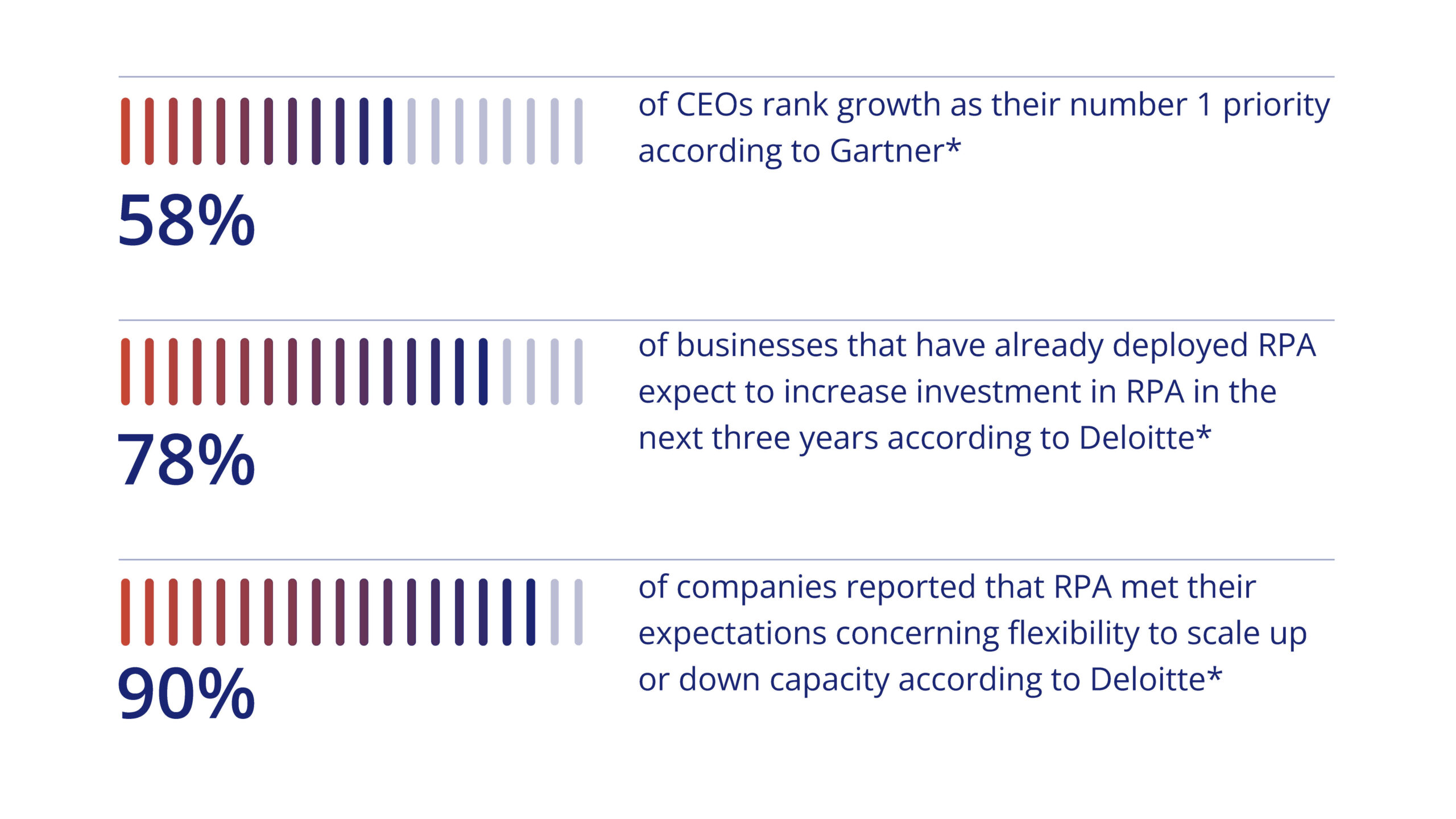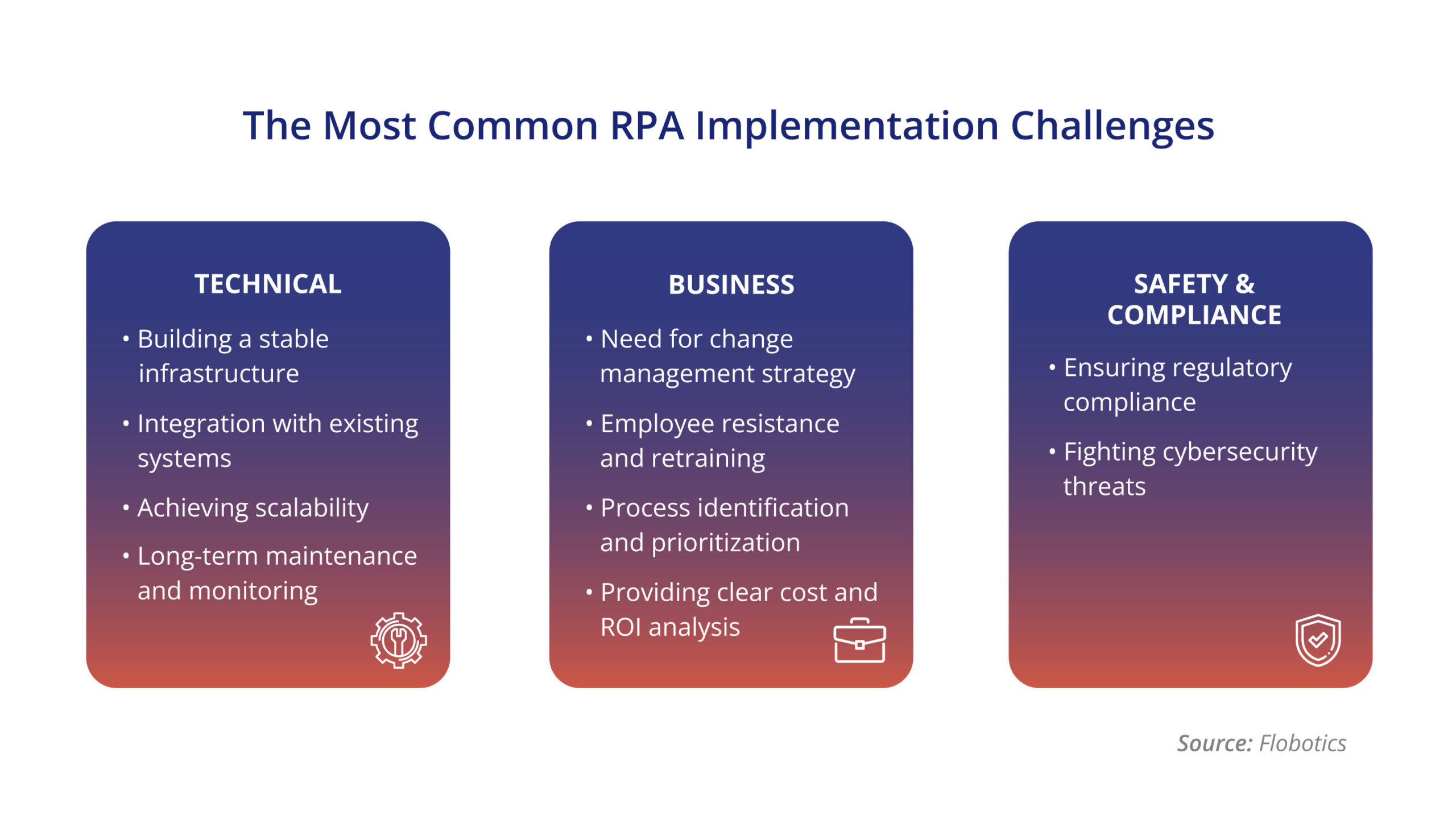Organizations today are walking a digital tightrope. Staying ahead of shifting changes in technology and business landscapes demands agility. A strong digital mindset that embraces continuous innovation and consistently exceeds expectations is a key element for success. One key tool for achieving this is Robotic Process Automation (RPA). From streamlining banking operations and insurance to optimizing retail and supply chains, automation is transforming industries with RPA at the forefront, driving efficiency and business growth.
RPA Benefits: How Automation Boosts Business Growth

RPA automates tasks by mimicking human actions at the user interface level. Unlike traditional automation methods reliant on complex back-end coding, RPA integrates seamlessly, replicating human interaction with various applications. This approach makes it a cost-effective and scalable solution, ideal for orchestrating well-defined, rule-based processes.
By automating repetitive tasks, RPA reduces workload, cuts costs by lowering full-time employees (FTEs), and enables teams to improve accuracy and efficiency, provide better availability, and ensure increased compliance. Robotic Process Automation’s ability to achieve business goals swiftly and cost-effectively without large-scale disruptions positions it as a standout technology for business process transformation.
- Lower Staffing Costs: Automating mundane, repetitive, and manually intensive tasks frees up valuable staff time, allowing the workforce to focus on higher-value business areas that require manual intervention and decision-making.
- Error Reduction and Enhanced Volume Handling: RPA significantly reduces error rates by replacing humans with bots for tasks like data entry and error reconciliation, as humans are prone to mistakes in these areas.
- Scalability and Increased Work Capacity: With bots working efficiently, organizations can scale up operations when demand increases and manage larger workloads.
- Enhanced Customer Service and Experience (CX): RPA provides a foundation to build AI and ML-powered customer service chatbots and tech support to answer common queries, thus improving customer experience
- Boosted Productivity and ROI: By automating various tasks, RPA helps enterprises become more productive and achieve higher returns on their investments in technology and people.

Navigating RPA Challenges: Roadblocks to Automation

According to a study by Ernst & Young, up to 50% of initial Robotic Process Automation (RPA) projects fail. The most common RPA challenges organizations face fall into three categories: technical, business, and regulatory.

Technical Challenges
- Scaling Up: As businesses grow, their data and workload demands increase, which can overwhelm RPA systems designed for smaller volumes. Furthermore, automated processes may need adjustments to comply with new regulations.
- Ongoing Maintenance: RPA bots require ongoing attention after deployment. Left unattended, even well-functioning systems can degrade due to software bugs or overloaded databases. Regular updates are needed to adapt to regulation changes, evolving business needs, and new technologies.
Business Challenges
- Employee Resistance: Employees accustomed to existing workflows may resist the introduction of RPA. This can slow down adoption and limit the effectiveness of automation initiatives.
- Process Selection: Not all processes are suitable for automation. Some steps within a process may be impossible to automate. Identifying the right processes for automation is crucial to avoid wasted time and resources.
Regulatory and Compliance Challenges
- Compliance: Regulations can create challenges for RPA implementation. Bots that handle sensitive data like customer records or financial information must comply with data security laws.
- Security Risks: RPA introduces a new potential entry point for cyberattacks. Security breaches can harm your business, customers, and reputation. In some industries, non-compliance fines can result from security incidents.
Optimizing Business Processes: A Five-Stage RPA Roadmap for Increased Efficiency

Careful planning and execution are essential for successful robotic process automation implementation. Each stage of the five-stage RPA roadmap, including planning, piloting, implementation, scaling, and steady-state operations, builds on the previous one, ensuring readiness for future changes and maintaining competitiveness. This helps build a strong foundation for companies to innovate quickly and achieve positive ROI.
1. Plan
Create a detailed plan based on clear business objectives. This plan will lay the foundation for the RPA initiative and ensure that the project’s goals align with the organization’s overall goals.
2. Pilot
Once the plan has support from all stakeholders, move on to the pilot stage. This stage allows the company to demonstrate the value of RPA and learn how to implement it effectively with minimal risk.
3. Implement
After completing the pilot project and reviewing its successes and failures, proceed to full implementation. This is a critical step, and the team must be prepared for new challenges as RPA is deployed at scale.
4. Scale
Following the initial deployment, the RPA team should seek ways to improve current solutions and implement new ones. Automation is rapidly evolving, so it is important to continually scale solutions to be more powerful and cover a wider range of processes.
5. Steady State
As the enterprise adapts to the new RPA solutions, it is crucial to avoid stagnation. RPA leadership must strive to sustain and improve RPA systems by fostering a culture of continuous automation and innovation.
 Building a Winning RPA Strategy: A Quick Guide to Successful Implementation
Building a Winning RPA Strategy: A Quick Guide to Successful Implementation

A well-crafted roadmap is essential to addressing RPA implementation challenges, but its success depends on adopting effective strategies. The following strategies can help ensure the successful implementation of your RPA roadmap.
Which are the key components of an RPA strategy?
A successful RPA strategy is built on a clear vision that aligns automation efforts with broader business objectives. It may involve assessing the skills required for RPA initiatives, effective management (whether through a centralized RPA Center of Excellence (CoE) or decentralized teams and defining KPIs to measure success. Before businesses can reap the benefits of RPA, they need to identify the right processes for automation, foster a strong partnership between business and IT, and establish robust governance and monitoring frameworks to ensure that RPA delivers tangible value.
Early and Continuous IT Collaboration
While Chief Operating Officers (COOs) were early adopters of RPA, initial implementations often faced roadblocks due to a lack of IT involvement. Involving IT from the outset ensures business units receive the necessary resources and avoids potential delays. Today’s “citizen developers” equipped with cloud-based RPA tools can implement solutions within their departments. However, CIOs should still be involved to provide guidance and prevent isolated initiatives that may hinder overall success.
Establishing an RPA Center of Excellence (CoE)
The most successful RPA deployments often have a dedicated CoE. This group, staffed with experts, champions RPA within the organization. Organizations can also look for companies providing dedicated RPA services to help them establish a CoE. While not every company has the budget for a formal CoE, even a designated team can develop strong business cases, calculate potential cost reductions and ROI, and track progress toward achieving these goals.
Focusing on Long-Term Value
Financial institutions implementing large-scale RPA for data entry or software monitoring generate significant data. However, focusing solely on data exploitation can divert attention from the core benefits of RPA. Instead, consider RPA as a strategic, long-term initiative, not a collection of piecemeal projects that could become cumbersome.
The Future Outlook: Reshaping Business with RPA and AI
RPA has transformed existing processes by increasing speed to market, eliminating waste, reducing errors, and enhancing customer experience. The future of RPA looks promising, with machine learning and artificial intelligence driving further advancements. Today, cognitive automation helps address critical issues such as improving customer satisfaction, reducing IT helpdesk tickets, and supporting HR initiatives to reduce attrition. As RPA continues to evolve, its impact on business efficiency and effectiveness will only grow stronger.
Whether it’s integrating RPA with your existing software or fostering an automation-friendly company culture, AppsTek Corp has helped numerous clients overcome RPA implementation challenges. Contact us to discover how we can support your business.



